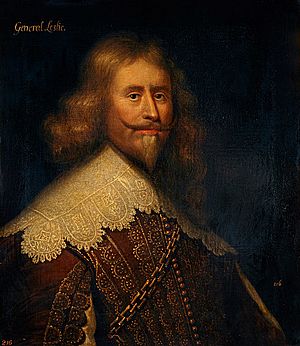Siege of Hereford facts for kids
Quick facts for kids Siege of Hereford |
|||||||
|---|---|---|---|---|---|---|---|
| Part of the First English Civil War | |||||||
 The Bridge over the River Wye was the scene of heavy fighting during the siege. |
|||||||
|
|||||||
| Belligerents | |||||||
| Commanders and leaders | |||||||
| Strength | |||||||
| 1,500 | 14,000 | ||||||
| Casualties and losses | |||||||
| Unknown | Unknown | ||||||
The Siege of Hereford happened in 1645 during the English Civil War. The city of Hereford was a strong base for the King's army, called the Royalists. A large Scottish army, known as Covenanters, attacked Hereford. They were led by the Earl of Leven.
The Covenanters were helping the English Parliamentarians. They wanted to capture Hereford after winning the Battle of Naseby. The siege lasted for about a month. But then, more Royalist soldiers were coming to help Hereford. Also, news arrived that Montrose had won battles against the Covenanters in Scotland. Because of this, Leven's army had to leave Hereford and go back.
However, Hereford did not stay in Royalist hands for long. In December of the same year, Colonel John Birch launched a surprise attack. His Parliamentarian forces captured the city. Hereford then stayed with the Parliamentarians for the rest of the war.
Contents
Why Hereford Was Important
Hereford and the nearby Welsh Marches were very important. Many people from these areas joined the King's army. In 1643, Parliamentarian troops briefly took Hereford. After this, Barnabas Scudamore became the new Governor. He worked hard to make Hereford's defenses much stronger.
Even though Hereford was a Royalist stronghold, people were getting tired of the war. In spring 1645, about 15,000 "clubmen" marched to Hereford. These were ordinary people who wanted the fighting to stop. Prince Rupert's forces broke them up.
The King's Plan
In 1645, the war started to go badly for King Charles I. On June 14, he lost the Battle of Naseby in Northamptonshire. This was a major defeat against the English New Model Army. King Charles went to Hereford to regroup. Then he moved into South Wales. He hoped to find new soldiers there, including Irish allies.
Meanwhile, Scottish Covenanter forces captured Carlisle on June 28. The Committee of Both Kingdoms then ordered them to attack Hereford. This was to stop the Royalists from building a new army. After arriving near Hereford, King Charles sent Rupert to Bristol. The King himself went to Cardiff to recruit more soldiers.
The Siege Begins

Leven's army moved into Herefordshire. They first attacked a fortified house at Canon Frome. This house was defended by Colonel Sir John Barnard. The Scottish forces stormed the house. They killed many defenders and executed Barnard.
When Leven reached Hereford, he had about 14,000 soldiers. Governor Scudamore had 1,500 defenders inside the city. There was a fight near the bridge over the River Wye. Leven then offered Scudamore a chance to surrender. But Scudamore refused because he needed the King's permission. He still hoped King Charles would send help from Wales. Leven made sure his soldiers did not steal from the local people.
Fighting and Damage
The Scottish army tried several times to storm the city. During one attack, the Scottish Major General Lawrence Crawford was killed. He was shot by a Royalist sniper. One of Hereford's old churches, St Martin's, was badly damaged. It was not fully rebuilt until much later. Some people thought Leven was too careful in how he led the siege.
King Charles was slowly gathering new troops. He was moving to help the defenders in Hereford. But then, Leven received alarming news. The Scottish Royalists had won a big victory. Their Irish Brigade, led by the Marquis of Montrose, won the Battle of Kilsyth.
Because of this, Leven decided to end the siege. He began to pull his troops back between September 1 and 2. He planned to march to Scotland to help his government. King Charles entered Hereford on September 4, officially ending the siege. He made Scudamore a knight for successfully defending the city. Then, King Charles marched north to Chester. He hoped to meet Montrose's forces there.
What Happened Next
Less than two weeks later, the Covenanters won a major victory. They defeated Montrose at the Battle of Philiphaugh in the Scottish Borders. This ended any chance of Montrose helping in the English war. Meanwhile, Prince Rupert had surrendered Bristol. The Royalists did not gain much from their victory at Hereford.
Leven's forces did not return to Scotland. Instead, they moved to attack Newark in Nottinghamshire. They eventually captured Newark after a long siege.
The story of the siege was included in a book. It was in Memoirs of a Cavalier, a novel written by Daniel Defoe in 1720. The book tells the story from the view of a Royalist soldier.
Hereford Falls to Parliament
In December, Parliamentarian forces moved quickly towards Hereford. They were led by John Birch and Thomas Morgan. On December 18, Birch launched a surprise night attack on Hereford. They captured the city and many of its defenders.
After Hereford fell, Governor Scudamore was accused of taking a bribe. People said he had given Hereford to the King's enemies. He was put in prison for several months in Worcester. Birch was made the new Governor of Hereford. The city stayed under Parliament's control for the rest of the First English Civil War. It also remained so during later conflicts.

